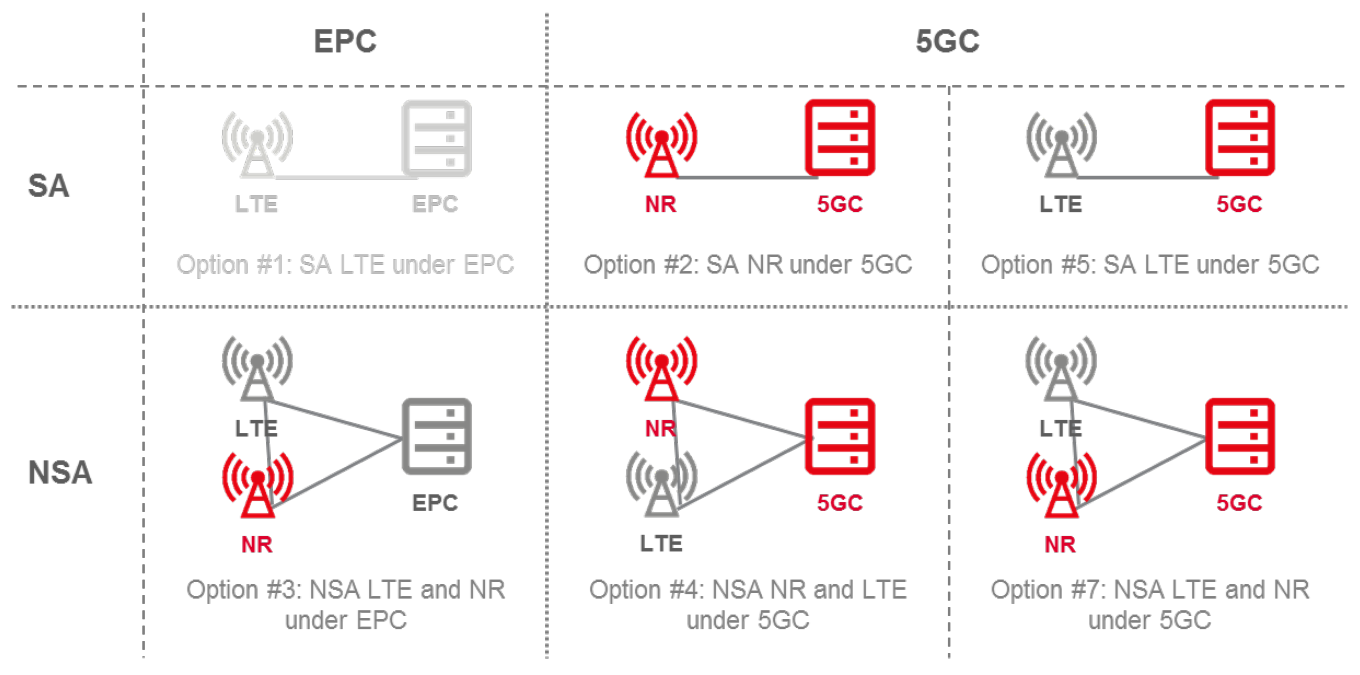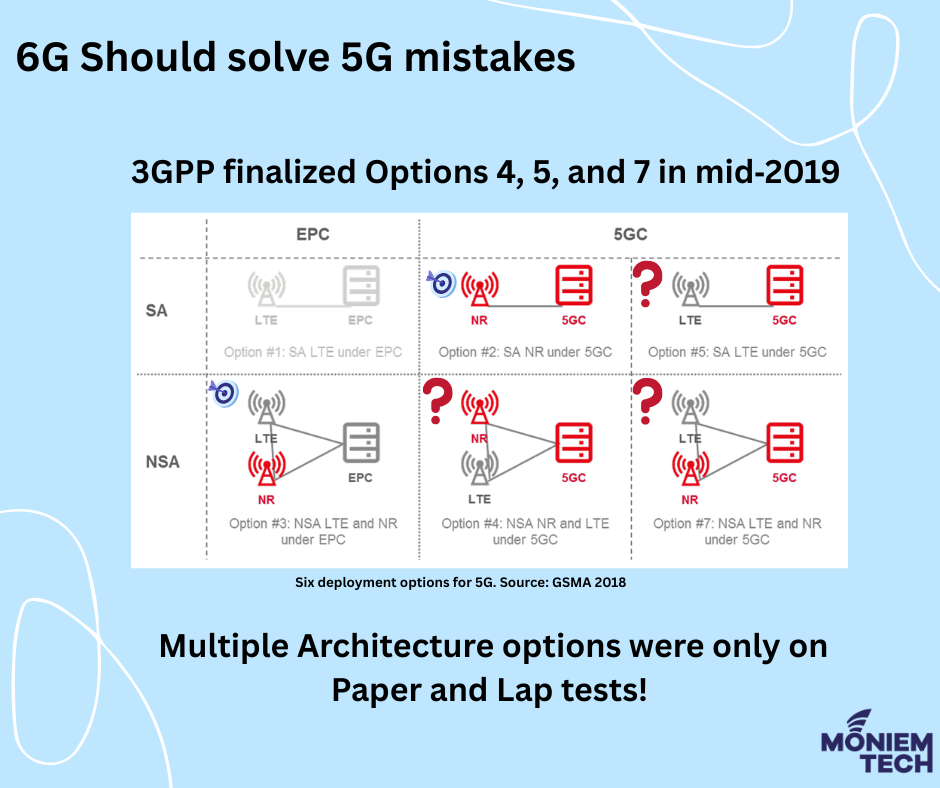For the introduction of 5G, 3GPP has specified five possible configurations, or ‘options’, for connecting to an EPC or a new 5G core network (six if the current 4G system is included).
The features that distinguish each Option are:
- Use of Dual Connectivity;
- Radio Access Technology acting as master node
- Core Network used.

The Options using Dual Connectivity are grouped under the term “Non-standalone” (NSA) to indicate that 5G radio access technology (NR) and LTE are used simultaneously to provide radio access. Options where only one radio access technology is in use are referred to as “Standalone” (SA).
It is widely expected that mobile operators will initially deploy 5G using Option 3, allowing the re-use of existing EPC Core functionality. Option 3 has been fully specified in an early drop of 3GPP Release 15.
The other deployment Options already fully specified by 3GPP are Option 2 and Option 5, both standalone options differing in the type of radio access technology connected to the new mobile core network 5GC. These options were completed in June 2018 (ASN.1 in September 2018).
In addition, 3GPP has finalised the two remaining Options, Option 4 and Option 7, which were completed in March 2019 (ASN.1 was finalised in June 2019).
GSMA surveys show operators want support for these options, but most will focus on Options 2 (Standalone NR–5GC) and 3/3x (NSA NR–EPC) for initial deployments
5G connectivity options Risk
Ericsson’s analysis explicitly discourages investments in Options 4, 5, and 7, viewing them as unnecessary detours from the long‑term architecture. Ericsson stated that Mobile network operators that deploy 5G must be able to support UE, radio network, core network and management products that are manufactured by a multitude of device and network equipment vendors. With multiple connectivity options and numerous possible combinations, there is a high risk that different operators will deploy different options in varying orders. If that happens, chipset, device and network equipment vendors are likely to get contradictory requirements from other operators or markets. This would cause significant product and integration complexity, as well as create interoperability issues that prolong the time it takes to establish a complete ecosystem that supports the deployed options.
The complexity caused by a multitude of deployed connectivity options would also impact the end-to-end (E2E) testing of services in the operator network, including both existing services, such as voice, and new ones. Further, the higher the number of options deployed, the more complex and time-consuming it will be for the operator community to establish 5G roaming in the industry.
Why options 4,5 and 7 aren’t widely deployed yet
The use of options 5, 7, and 4 would add unnecessary complexity to the target architecture, particularly in its interaction with other network functions and in the evolution of new features, which must take into account the combination of all existing options.
- Option 5 aims to extend 5GC coverage to areas without NR by using eLTE, but it requires significant investment in new UEs, RAN upgrades, and interoperability testing. It doesn’t offer a faster or more efficient path to wide-area 5GC coverage compared to Option 2, which is preferred for long-term evolution.
- Option 7 builds on Option 5 by adding dual connectivity with NR, but shares the same limitations. Since Option 5 is not recommended, Option 7 is also not favored.
- Option 4 complements Option 2 by adding eLTE to an NR anchor to boost throughput when NR spectrum is limited. However, it requires additional complexity and long-term investment in eLTE. It is unnecessary when NR spectrum and NR-NR carrier aggregation are sufficient, making Option 2 the better strategic choice.
What Operators Actually Do
Most operators use a stepwise evolution:
-
-
Launch NSA Option 3 (NR + LTE on EPC core).
-
Migrate to SA Option 2 (Pure NR on 5GC).
-
These two options dominate the market strategy—Options 4/5/7 are not part of mainstream deployments.

6G Role in Solving 5G Multiple Architecture Issue
Option 5 relies on legacy eLTE, requiring complex interworking and device upgrades. Option 7 adds more complexity with dual connectivity between eLTE and NR. 6G is expected to use a native, unified architecture—fully cloud-native, software-defined, and backward-compatible. This eliminates the need for transitional options, such as Option 5/7, and reduces fragmentation between LTE, NR, and core networks. Also, 6G will introduce AI-native and context-aware core networks, which dynamically adapt based on use case and user context. This avoids overbuilding and supports wide-area services only where needed, reducing the dependency on transitional deployment models.
6G will also push towards zero-touch provisioning, open interfaces (Open RAN), and software-upgradable hardware, making network updates less invasive and more cost-effective, reducing the barriers seen in 5G Options 4/5.
6G will eliminate the need for complex fallback options (like 5G Option 5/7/4), reduce reliance on legacy networks (like LTE in Option 4), and enable seamless, intelligent connectivity through a unified, adaptive, and cloud-native architecture. It is designed to bypass the transitional inefficiencies that 5G is currently trying to overcome.
